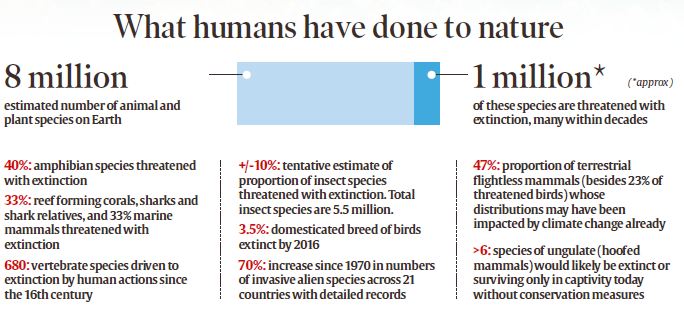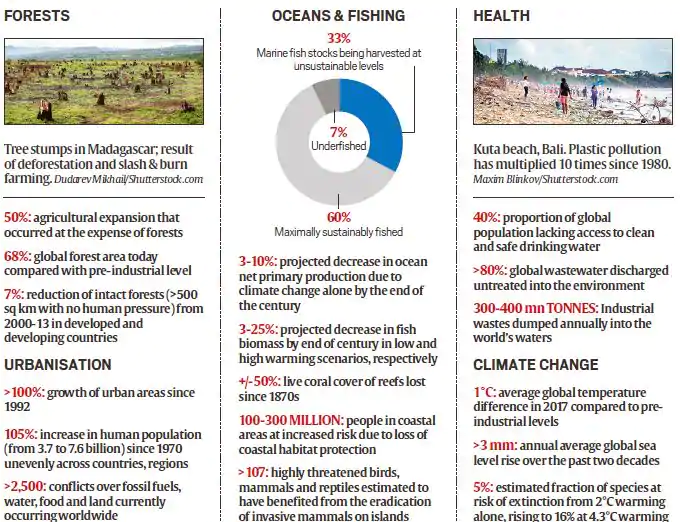Why in news?
The Intergovernmental Science-Policy Platform on Biodiversity and Ecosystem Services (IPBES) recently released a report.
What is IPBES?
- IPBES is an independent intergovernmental body, established by member States in 2012.
- It is a global scientific body, similar in composition and functioning to the Intergovernmental Panel on Climate Change (IPCC).
- IPCC’s assessment reports form the scientific basis on which the international negotiations on climate change have been happening.
- IPBES is often described as the “IPCC for biodiversity”, as it is mandated to do a similar job for natural ecosystems and biodiversity.
- The objective is to strengthen the science-policy interface for biodiversity and ecosystem services.
How does it differ from IPCC?
- Like IPCC, IPBES does not produce any new science. It only evaluates existing scientific knowledge to make assessments and projections.
- However, unlike IPCC, the IPBES assessment reports are likely to feed into and inform several multilateral processes.
- Two UN Conventions are likely to be guided by this report in future, -
- Convention on Biological Diversity that addresses biodiversity issues
- Convention on Combating Desertification that deals with sustainable land management
- Besides, the Ramsar Convention, Convention on International Trade in Endangered Species, and Cartagena Protocol may also find some inputs.
What is the present report on?
- The present one is the first global assessment report by the IPBES. [IPCC, set up in 1988, has produced 5 reports so far.]
- It includes a systematic review of 15,000 scientific and government sources and resources collected from indigenous and local knowledge.
- The IPBES report makes a comprehensive scientific evaluation of the state of Earth's natural ecosystems.
- It gives a detailed account of health of the species that inhabit earth and the condition of habitats that they live in and depend upon.
- It ranks “five direct drivers” that cause changes in nature that have the largest relative global impact.
- In descending order, these include:
- changes in land and sea use
- direct exploitation of organisms
- climate change
- pollution
- invasive alien species
What are the key findings?
- The health of ecosystems that humans and other species depend on is “deteriorating more rapidly than ever”.
- As many as 1 million different species are facing the threat of extinction, more than at any previous time.
- This is out of a total of an estimated 8 million plant and animal species.
- The threat is because of changes brought about in natural environments by human activities.
- The current rate of global species extinction is “tens to hundreds of times” higher compared to the average over the last 10 million years.
- Even for global warming of 1.5 to 2 degree Celsius, the majority of terrestrial species ranges are projected to shrink profoundly.
- Natural habitats are being destroyed at an accelerating pace.
- 75% of earth’s land surface and 66% marine environments have been “significantly altered”.
- Over 85% of wetland area had been lost.
- But, on an average, these trends were less severe on areas controlled or managed by indigenous people and local communities like the tribes.
- The negative trends in nature are expected to continue to 2050 and beyond in all of the policy scenarios explored in the assessment.


What is the relevance for India?
- The report does not have country-specific information.
- However, India can identify with most of the trends pointed out in the report.
- The major biodiversity hotspot, vast areas, especially the coastline, of which are under tremendous stress due to large population, makes some findings very relevant to India.
- E.g. 23% of global land area had shown a reduction in productivity due to degradation
- Also, 100 to 300 million people are said to be at an increased risk of floods and hurricanes due to loss of coastal habitats and protection.
- The other findings in connection with India include the following:
- plastic pollution had increased 10 times from 1980
- the number of large dams (those with a height of 15 m or more) had reached almost 50,000
- human population had more than doubled since 1970s
- the number of urban areas had doubled since 1992
- All these trends have been clearly visible in the case of India and thus bring with them the associated risks to natural ecosystems.
What is the way forward?
- The report says there is still an opportunity for human beings to live in harmony with nature.
- But there has to be a change in the way how natural resources are governed, and things are produced and consumed.
- This is inevitable in terms of economies, livelihoods, food security, health and quality of life worldwide.
Source: Indian Express

